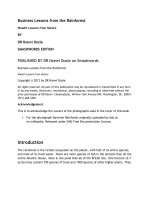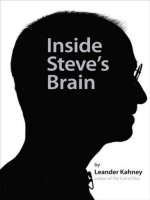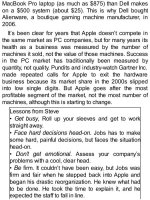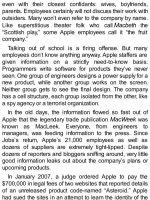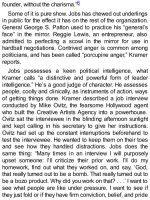Inside Steve''''s Brain Business Lessons from Steve Jobs, the Man Who Saved Apple by Leander Kahney_6 docx
Bạn đang xem bản rút gọn của tài liệu. Xem và tải ngay bản đầy đủ của tài liệu tại đây (119.02 KB, 25 trang )
engineers, and back to Steve. Two full days of demos,
drawings of the various designs, marketing presentations
—I was overwhelmed.
On Monday I called Doug Fairbairn at VTI and told him
I had changed my mind.
8
Once he’d assembled his team, Jobs gave them the
freedom to be creative and shielded them from the growing
bureaucracy at Apple, which tried several times to shut
down the Mac project because they viewed it as an
unimportant distraction. “The people who are doing the
work are the moving force behind the Macintosh. My job is
to create a space for them, to clear out the rest of the
organization and keep it at bay,”
9
Jobs wrote in a 1984
essay that was printed in the inaugural issue of Macworld
magazine. Hertzfeld put it more bluntly: “The most important
thing Steve did was erect a giant shit-deflecting umbrella
that protected the project from the evil suits across the
street.”
10
As well as recruiting the best talent, Jobs is quick to get
rid of those who don’t measure up. Hiring only insanely
great employees and firing the bozos has been one of
Jobs’s longest held managerial principles. “It’s painful when
you have some people who are not the best people in the
world and you have to get rid of them; but I found that my job
has sometimes exactly been that—to get rid of some
people who didn’t measure up and I’ve always tried to do it
in a humane way. But nonetheless it has to be done and it
is never fun,” Jobs said in a 1995 interview.
11
Small Is Beautiful
Jobs likes to work in small teams. He didn’t want the
original Mac team to exceed one hundred members, lest it
became unfocused and unmanageable. Jobs firmly
believes that small teams of talented employees run circles
around larger groups. At Pixar, Jobs tried to ensure that the
company never grew to more than a few hundred people.
When asked to compare Apple and Pixar, Jobs attributed
much of its success to its small size. “Apple has some
pretty amazing people, but the collection of people at Pixar
is the highest concentration of remarkable people that I
have ever witnessed,” Jobs told Fortune in 1998. “There’s
a person who’s got a Ph.D. in computer-generated plants
—3-D grass and trees and flowers. There’s another who is
the best in the world at putting imagery on film. Also, Pixar
is more multidisciplinary than Apple ever will be. But the
key thing is that it is much smaller. Pixar’s got 450 people.
You could never have the collection of people that Pixar has
now if you went to two thousand people.”
Jobs’s philosophy harks back to the old days when he,
Wozniak, and a few teenage friends assembled computers
by hand in a garage. To some extent, Jobs’s preference for
small development teams at Apple today is the same thing:
a simulation of a garage startup inside a big company with
more than 21,000 employees.
On returning to Apple in 1997, Jobs set about
assembling an A team to resurrect the company. Several of
the top executives he appointed had worked with him
before at NeXT, including Jon Rubinstein, who he put in
charge of hardware; Avie Tevanian, who headed up
software; and David Manovich, who was put in charge of
sales. Jobs has a reputation as a micromanager, but at
NeXT he had learned to trust these lieutenants. He no
longer oversees every decision the way he used to. At
Pixar, Jobs delegated almost everything to Catmull and
Lasseter. At Apple, Jobs cedes much of the day-to-day
management to Tim Cook, the chief operating officer, a
master at operations and logistics who is widely
considered the number two at Apple. When Jobs took six
weeks’ sick leave in 2005 after his cancer operation, Cook
took over as acting CEO. Ron Johnson, head of retail,
manages almost everything to do with Apple’s chain of
retail stores; while chief financial officer Peter
Oppenheimer handles finances and deals with Wall Street.
Delegation at Apple frees up Jobs to do what he loves best
—develop new products.
Jobs’s Job
Working with partners like Jonathan Ive and Jon Rubinstein,
Jobs plays a unique role. He doesn’t design circuit boards
or write code, but Jobs puts his stamp firmly on his teams’
work. He’s the leader who provides the vision, guides the
development, and makes many of the key decisions. “He
didn’t create anything really, but he created everything,”
wrote former CEO John Sculley on Jobs’s contribution to
the original Mac. According to Sculley, Jobs once said to
him: “The Macintosh is inside of me, and I’ve got to get it
out and turn it into a product.”
12
Jobs acts as the team director, the arbiter who rejects or
accepts the work of his creative partners, guiding them as
they work toward a solution. One source told me that Ive
once confided that he wouldn’t be able to do the work he
does without Jobs’s input. Ive may be a creative genius, but
he needs Jobs’s guiding hand.
Jobs is the “product picker,” in the parlance of Silicon
Valley. A product picker is a term used by Silicon Valley
venture capitalists to identify the key product person at
startup companies. By definition, a startup must succeed
on its first product. If it doesn’t, it goes under. But not all
startups start with a product. Some startups are a group of
engineers who have a lot of talent and ideas, but haven’t yet
figured out what product they want to develop. This
happens all the time in the Valley, but to ensure the success
of a startup like this, there has to be an individual who’s got
a nose for what that product should be. It’s not always the
CEO or a top executive, and they may not have expertise in
management or marketing: their skill is picking out the key
product from a torrent of ideas.
“The products bubble up but there has to be a czar,”
explained Geoffrey Moore, a venture capitalist and
technology consultant. Moore is the author of Crossing the
Chasm, the best-selling book about bringing high-tech
products to the mainstream that is revered as Silicon
Valley’s marketing bible. “The success or failure of a
startup depends on its first product,” continued Moore. “It’s
a hits business. Startups must have a hit or they’ll fail. If you
pick the right product you win big.”
13
Moore said Jobs is the consummate product picker. One
of the key things Moore looks for in pitch meetings when
startups are looking for venture capital is the fledgling
company’s product picker. Picking products doesn’t work
by committee— there has to be an individual who is able to
act as a decision maker.
General Motor’s vice chairman Bob Lutz, the legendary
“car czar,” is a good example. An ex-Chrysler, Ford, and
BMW executive, Lutz is famous for a string of distinctive,
design-driven hit cars like the Dodge Viper, Plymouth
Prowler, and BMW 2002. He’s a quintessential “car guy”
who knocks out distinctive vehicles rather than the
designed-by-committee look-alikes of competitors. Ron
Garriques, a former Motorola executive responsible for the
hit Razr mobile phone, is another example. In 2007,
Garriques was recruited by Michael Dell—newly returned to
his troubled company—to run Dell’s consumer business,
and pick hit products, no doubt.
“It’s a high-wire act,” said Moore. “It’s very clear when you
fail. You have to risk everything every time you do it. It’s
playing center court at Wimbledon. And you have to have a
lot of power to do it. Not many have the power or the will to
push it through [the] organization without being edited or
compromised or watered down. It doesn’t work if you pick
by committee.”
At Apple, Jobs has successfully picked and guided to
development a hit product every two or three years—the
iMac, the iPod, the Mac Book, the iPhone. “Apple is a hit-
driven company,” said Moore. “It’s had one hit after
another.”
For much of the last century, there were myriad
companies run by similar strong-willed product czars, from
Thomas Watson Jr. at IBM to Walt Disney. But the number
of successful companies with product czars at the helm,
like Sony under Akio Morita, has dwindled in recent years.
Many contemporary companies are run by committee.
“What’s missing today is that these kind of entrepreneurs
are no longer there,” lamented Dieter Rams, the design
genius who helped propel Braun to prominence for several
decades. “Today there is only Apple and to a lesser extent
Sony.”
14
Pugilistic Partners
During product development, Jobs is involved in many
major decisions, from whether there should be fans for
cooling machines to the font used on the box. But although
Jobs is king of the mountain, the decision making at Apple
isn’t all top down. Argument and debate are central to
Jobs’s creative thinking. Jobs wants partners who
challenge his ideas, and whose ideas can be challenged
by him, often forcefully. Jobs makes decisions by engaging
in hand-to-hand intellectual combat. It’s demanding and
pugnacious, but rigorous and creative.
Take the pricing of the first Mac in 1984. Jobs wrestled
the pricing of the Mac with Sculley for several weeks. Not a
couple of meetings. They argued about the issues night
and day for weeks. The pricing of the Mac presented a big
problem. Apple’s revenues were on the slide, and the Mac
had been expensive to develop. Sculley wanted to recoup
the R&D investment, and he wanted to raise enough money
to strategically out-advertise the competition. But if the Mac
was priced too high, it might scare off buyers and wouldn’t
sell in volume. Both men took turns debating the opposing
side of the argument—the thesis and antithesis—playing
devil’s advocate to see where the arguments would lead.
Sculley euphemistically called arguing with Jobs “jousting.”
“Steve and I enjoyed taking one position, then turning it
around and adopting another argument,” Sculley wrote.
“We would constantly joust over what each of us thought
about new ideas, projects and colleagues.”
There was likely similar “jousting” at Apple when the
iPhone was launched in the summer of 2007. The iPhone
initially cost $600, but within two months of its release, Jobs
had dropped the price to $400. There were howls of
protests from early adopters, who rightly felt ripped off. The
outcry was so vociferous, Jobs issued a rare public
apology and a $100 rebate.
Jobs dropped the iPhone’s price because the initial
response had exceeded Apple’s expectations—it had sold
more than one million units—and Jobs saw an opportunity
to rapidly ramp up sales in the crucial holiday period. For a
lot of consumer electronics, including the iPod, there are as
many sales during the holiday period as there are the rest
of the year. "iPhone is a breakthrough product, and we
have the chance to ‘go for it’ this holiday season,” Jobs
wrote in a note to customers on the Apple website. “iPhone
is so far ahead of the competition, and now it will be
affordable by even more customers. It benefits both Apple
and every iPhone user to get as many new customers as
possible in the iPhone ‘tent.’ ”
Day to day at Apple, meetings with Jobs can often be
arguments—long, combative arguments. Jobs relishes
intellectual combat. He wants a high-level discussion—
even a fight— because it’s the most effective way to get to
the bottom of a problem. And by hiring the best people he
can find, he ensures the debate is at the highest possible
level.
A meeting with Jobs can be a trial by fire. He’ll challenge
everything that is said, sometimes extremely rudely. But it’s
a test. He is forcing people to stick up for their ideas. If they
feel strongly enough, they’ll defend their position. By raising
the stakes, and people’s blood pressures, he’s testing to
see if they know their facts and have a strong argument.
The more firmly they stand, the more likely they’re right. “If
you’re a yes-man you’re doomed with Steve because he’s
pretty confident about what he knows, so he needs
someone to challenge him,” ex-Apple programmer Peter
Hoddie told me. “Sometimes he says, ‘I think we need to
do this’—and it’s a test to see if anyone will challenge him.
These are the kinds of people he’s looking for.”
15
It’s extremely difficult to bullshit Jobs. “If you don’t know
what you’re talking about, he’s going to find out,” said
Hoddie. “He’s really bright. He’s extremely well informed.
He has access to some of the best people on the planet. If
you don’t know what you’re talking about, he’s gonna
know.”
Hoddie described one occasion when he was arguing
with Jobs about some new chip technology under
development at Intel, the processor supplier. Occasionally,
Hoddie would bullshit Jobs just to get him off his back.
Later that day, Jobs cornered Hoddie and challenged him
about his earlier statements about Intel. Jobs had phoned
up Intel’s chairman, Andy Grove, and asked him about the
technology Hoddie had been talking about. Luckily, Hoddie
hadn’t been bullshitting. “You can’t bluff someone who can
pick up the phone and talk to Andy,” Hoddie said, laughing.
During his thirty-year career, Jobs has maintained a
string of creative partnerships, beginning with his high
school buddy Steve Wozniak. The list includes the original
Mac design team, from the hardware genius Burrell Smith
to programming luminaries such as Alan Kay, Bill Atkinson,
and Andy Hertzfeld. In the decade Jobs has been working
with design genius Jonathan Ive, Apple has led the world in
industrial design. His partners at Apple include Jon
Rubinstein, who oversaw a string of hit hardware, from the
iMac to the iPod; and Ron Johnson, who masterminded
Apple’s retail stores, one of the most successful
moneymaking chains ever (more on the stores later). And
at Pixar, his teaming with Ed Catmull and John Lasseter
created a moviemaking powerhouse.
“Think Different”
One of Jobs’s most productive working partnerships has
been with Lee Clow, a tall, bearded hippie adman and his
agency, TBWA /Chiat/Day. Jobs’s partnership with Clow
and his agency has spanned several decades and
produced some of advertising’s most memorable and
influential campaigns, from the 1984 TV spot that
introduced the Macintosh, to the iPod silhouette ads
plastered across billboards worldwide.
Headquartered in Los Angeles, TBWA/Chiat/Day is
considered one of the most creative advertising companies
in the world. Cofounded in 1968 by Guy Day, an L.A. ad
veteran, and Jay Chiat, a hard-driving New Yorker who
relocated to sunny Southern California in the mid-1960s,
the company is now run by its longtime creative director
Lee Clow. The company was once considered “gonzo” for
its controversial, sometimes reckless, approach to
advertising, but has matured and now boasts sober, blue-
chip clients such as Nissan, Shell, and Visa.
For Apple the company has produced widely acclaimed,
award-winning campaigns that are often regarded more as
cultural events than mere advertising blitzes. Ads like “Think
Different,” “Switchers,” and “I’m a Mac” have been widely
discussed, critiqued, parodied, and copied. When a
campaign spawns hundreds of parodies on YouTube and
is turned into a sketch on late-night comedy shows, then the
ads have graduated from the commercial to the cultural
realm.
Jobs’s association with the ad company began in the
early 1980s, when the agency—then known as Chiat/Day—
was producing a series of popular ads for Apple’s
computers. In 1983, the agency began work on what would
become one of the most celebrated ads in advertising
history: the TV commercial that introduced the Macintosh
during the third quarter of the Super Bowl in January 1984.
The spot began with a tag line taken from another,
discarded ad: “Why 1984 won’t be like ‘1984’ ”—a
reference to George Orwell’s dystopian novel. It was too
good a line to just throw away, so the agency pitched it to
Apple. And, of course, it was perfectly suited for the launch
of the Mac. The agency hired British director Ridley Scott,
who’d just finished filming Blade Runner, to film the ad on a
London soundstage. Using a cast of British skinheads,
Scott portrayed a bleak Orwellian future, where a Big
Brother squawking propaganda from a giant TV cows the
masses into submission. Suddenly, in rushes an athletic
woman in a Macintosh T-shirt, who smashes the screen
with the toss of a sledgehammer. The sixty-second spot
never showed the Mac, nor any computer, but the message
was clear: the Mac would free downtrodden computer
users from the hegemony of IBM.
Apple’s board of directors was shown the spot just a
week before it was due to air and freaked out. They
ordered the ad pulled from the Super Bowl, but Chiat/Day
was unable to sell the slot in time and the ad ran.
It turned out to be fortuitous: the ad garnered more
attention and more press than the game itself. Although it
was shown only twice (during the Super Bowl and earlier,
on an obscure TV station in the middle of the night to make
it eligible for advertising awards), the ad was rebroadcast
in countless news reports and on Entertainment Tonight.
Apple estimated that more than 43 million people saw the
ad, which was worth millions of dollars in free advertising,
according to an estimate by then-CEO John Sculley.
“The commercial changed advertising; the product
changed the ad business; the technology changed the
world,” wrote Advertising Age columnist Bradley Johnson
in a 1994 retrospective. “It turned the Super Bowl from a
football game into advertising’s Super Event of the year
and it ushered in the era of advertising as news.”
16
The “1984” ad is typical of Jobs. It was bold and brash,
and unlike any other commercial of its time. Instead of a
straightforward product presentation, “1984” was a mini-
movie with characters, a narrative, and high production
values. Jobs didn’t think of it, write it, or direct it, but he was
smart enough to team up with Lee Clow and Jay Chiat, and
give them the room to be creative.
The “1984” ad went on to win at least thirty-five awards
for Chiat/Day, including the Grand Prix at Cannes, and
generated millions of dollars in new commissions and
clients. It also ushered in an era of lifestyle advertising that
downplayed a product’s features in favor of its appeal. No
one else was thinking about advertising in the same way,
especially in the computer industry; and very few
companies were willing to communicate with the public in
such an original, unorthodox way. Jobs left Apple in 1985
and the company switched agencies not long after his
departure. But when Jobs returned in 1996, he brought
back the agency to create a campaign that would “refocus”
Apple.
Jobs was concerned about Apple’s lack of focus, and
asked Chiat/Day to create a campaign that would speak to
Apple’s core values. “They asked us to come in and talk
about what Apple needed to do to get its focus back,” Clow
said. “It really wasn’t hard; it was just to go back to Apple’s
roots.”
17
Clow, who’s habitually dressed in T-shirt, shorts, and
sandals, said the idea for “Think Different” came from
thinking about the Mac user base—the designers, artists,
and creatives who remained loyal customers through the
company’s darkest days. “Everybody immediately
embraced the idea that this campaign should be about
being creative and thinking out of the box,” Clow said. “It
got bigger when we said why not celebrate anyone who’s
ever thought about ways that they could change the world,
and that’s when Gandhi and Edison started coming into the
conversation.”
18
The campaign came together very quickly and featured a
series of black-and-white photos of about forty famous
iconoclasts, including Muhammad Ali, Lucille Ball and Desi
Arnaz, Maria Callas, Cesar Chavez, Bob Dylan, Miles
Davis, Amelia Earhart, Thomas Edison, Albert Einstein,
Jim Henson, Alfred Hitchcock, John Lennon and Yoko Ono,
the Reverend Martin Luther King Jr., Rosa Parks, Picasso,
Jackie Robinson, Jerry Seinfeld, Ted Turner, and Frank
Lloyd Wright. Apple ran the ads in magazines and
billboards, and aired a TV ad celebrating “the misfits, the
rebels, the troublemakers . . . the crazy ones.”
“The people who are crazy enough to think they can
change the world are the ones that do,” the ad proclaimed.
The commercial came at a critical time in Apple’s
history. The company needed a public statement of its
values and its mission: as much for its employees as for its
customers. The “Think Different” campaign trumpeted
Apple’s virtues: its creativity, its uniqueness, and its
ambitions. Again, it was a big, bold statement—Apple was
associating itself, and its users, with some of humankind’s
most celebrated leaders, thinkers, and artists.
The photos were run without identifying labels, a strategy
previously used by the agency for a 1984 Nike campaign
featuring famous athletes. The lack of labels challenged the
viewer to figure out who the subject was. This strategy
makes the ads inclusive and involving. It rewarded those in
the know. If you knew who the ad featured, it saluted you as
an insider, part of the cognoscenti.
Jobs was involved from the beginning, submitting
personal heroes like Buckminster Fuller and Ansel Adams.
He also used his extensive contacts and formidable
persuasive powers to secure permissions from the likes of
Yoko Ono, John Lennon’s widow, and the estate of Albert
Einstein. But he declined the agency’s suggestion to
feature Jobs himself in one of the ads.
Out-advertise the Competition
Advertising has always been extremely important to Jobs,
second only to the technology. Jobs’s long-stated ambition
is to make computers accessible to all, which to him means
they have to be advertised to the public. “My dream is that
every person in the world will have their own Apple
computer. To do that, we’ve got to be a great marketing
company,” he has said.
1 9
Jobs is immensely proud of
Apple’s advertising. He often debuts new ads during his
Macworld keynote speeches. If he’s giving a product
presentation, there’s usually an ad to accompany the new
product, and Jobs always shows it off to the public. If the ad
is particularly good, he’ll show it twice, obviously delighted.
More than anyone else in the PC industry, Jobs has
strived to create a unique, non-nerdy image for computers.
In the late 1970s, Jobs hired Regis McKenna, a Silicon
Valley advertising pioneer, to help make Apple’s early
machines appeal to ordinary consumers. The advertising
had to communicate to consumers why they needed one of
these new PCs. There was no inherent demand for home
computers: the ads would have to create it. McKenna
drafted colorful ads showing computers in domestic
settings. The ads were written in simple, easy-to-
understand language, with none of the technical jargon that
dominated competitors’ ads, who, after all, were trying to
appeal to a completely different market—hobbyists.
The first magazine ad for the Apple II shows a preppy
young man playing with the machine on a kitchen table,
while his wife, washing the dishes, looks on adoringly. The
ad’s sexual politics may have been old-fashioned, but it
conveyed a message that Apple’s PCs were useful,
utilitarian machines. The kitchen setting made them seem
like just another labor-saving appliance.
The importance of advertising to Jobs is clearly
illustrated by his choice of CEO to run Apple in its early
days: John Sculley, a marketing executive from PepsiCo
who had used advertising to build Pepsi into a Fortune 500
company. Sculley was Apple’s CEO for ten years, and
though he made some strategic mistakes, he was
stunningly successful at using marketing to grow Apple.
When he took over in April 1983, Apple had $1 billion in
revenues. It was a $10 billion company when he left a
decade later.
In 1983, Apple was one of America’s fastest growing
companies, but it needed an experienced executive to
manage growth. Just twenty-six, Jobs was judged by
Apple’s board to be too young and inexperienced to handle
the job himself, so Jobs spent many months finding an
older executive he could work with.
He chose Sculley, the thirty-eight-year-old president of
PepsiCo, who’d masterminded the “Pepsi Generation”
advertising campaign, which helped unseat Coke as the
number-one brand for the first time in its history. Jobs spent
several months courting Sculley, an experienced executive
and a marketer extraordinaire, to run the company.
During the “Cola Wars” of the ’70s, Sculley massively
boosted Pepsi’s market share by spending huge sums of
cash on savvy TV advertising. Expensive, slick campaigns
like the “Pepsi Challenge” transformed Pepsi from an
underdog into a soda giant on equal footing with Coca-
Cola. Jobs wanted Sculley to apply the same advertising
chops to the fledgling market for personal computers. Jobs
was especially worried about the Macintosh, which would
debut in a few months. Jobs felt that advertising would be
one of the major factors in its success. He wanted the Mac
to appeal to the general public—not just electronics freaks
—and advertising a weird and unfamiliar new product
would be key to that. Sculley had no technology experience
whatsoever, but it didn’t matter. Jobs wanted his marketing
expertise. Jobs wanted to create an “Apple Generation.”
Sculley ran Apple in partnership with Jobs. He became
Jobs’s mentor and teacher, applying his marketing
expertise to the nascent but rapidly growing PC market.
Sculley and Jobs’s strategy at Apple was to build sales
rapidly and then out-advertise the competition. “Apple
hadn’t yet realized that as a billion-dollar corporation it had
immense advantages we hadn’t exploited,” Sculley wrote in
his autobiography, Odyssey. “It’s almost impossible for a
company with sales of $50 million or even $200 million to
invest in the kinds of effective television advertising
campaigns you need if you’re going to leave any
impression at all.”
20
Jobs and Sculley immediately boosted Apple’s
advertising budget from $15 million to $100 million. Sculley
said their goal was to make Apple “first and foremost a
product marketing company.” Many critics have dismissed
Apple’s advertising flair, rejecting it as trivial and
unimportant. Pure flash; no substance. But at Apple,
marketing has always been one of its key strategies. Apple
has used advertising as an extremely important and
effective way to distinguish itself for the competition. “Steve
and I were convinced we had the secret formula—a
combination of revolutionary technology and marketing,”
wrote Sculley.
21
Sculley’s ideas have been very influential on Jobs, laying
the groundwork for many of Jobs’s marketing techniques at
Apple today.
At PepsiCo, Sculley was responsible for some of the
earliest and most successful examples of lifestyle
advertising— emotionally charged spots that tried to reach
people’s minds through their hearts. Rather than try to
market specific attributes of Pepsi over other sodas, which
were negligible, Sculley created advertising that articulated
an “enviable lifestyle.”
Sculley’s “Pepsi Generation” ads featured wholesome
American kids engaged in idealized leisure pursuits:
playing with puppies in a field or eating watermelon at a
picnic. They portrayed uncomplicated vignettes of life’s
magic moments, set in a mythical middle America. They
were designed to appeal to baby boomers—the fastest-
growing, wealthiest consumers in the post-World War II
economy—by portraying a lifestyle they’d aspire to. They
were the first “lifestyle” ads.
The Pepsi commercials were treated like miniature
movies, shot with the highest production values by
Hollywood filmmakers. When other companies were
spending $15,000 to shoot a commercial, Pepsi spent
between $200,000 and $300,000 for a single spot.
22
Jobs does exactly the same thing at Apple today. Apple
is famous for its lifestyle advertising. It never loads its ads
with speeds and feeds, functions and features, like
everyone else. Instead, Apple engages in lifestyle
marketing. It portrays hip young people with “enviable
lifestyles,” given to them courtesy of Apple’s products.
Apple’s highly successful iPod ad campaign shows young
people grooving to the music in their heads. There is never
any mention of the iPod’s hard capacity.
Sculley also perfected big splashy marketing events, like
Macworld, as news. Sculley dreamed up the “Pepsi
Challenge”— a blind taste test that pitted Pepsi against
Coke, staged at grocery stores, malls, and big sports
events. These challenges often caused such a splash that
they would often attract local TV crews. A spot on the local
TV news that evening was worth far more than any thirty-
second commercial. Sculley upped the stakes: organizing
celebrity challenges at big sports games that would often
garner massive publicity. “Marketing, after all, is really
theater,” Sculley wrote. “It’s like staging a performance. The
way to motivate people is to get them interested in your
product, to entertain them, and to turn your product into an
incredibly important event. The Pepsi Generation
campaign did all this in scaling Pepsi to epic proportions
and making a brand bigger than life.”
23
Jobs uses the same technique to introduce new products
at the annual Macworld Expo. Jobs has turned his
trademark “one more thing” keynote speeches at Macworld
into massive media events. They are marketing theater,
staged for the world’s press.
One More Thing: Coordinated Marketing
Campaigns
The Macworld speech is just one part of much bigger,
coordinated campaigns that are executed with a precision
that would impress a general. The campaigns combine
rumor and surprise with traditional marketing, and rely
wholeheartedly on secrecy for their effectiveness. On the
outside it can look somewhat chaotic and uncontrolled, but
they are tightly planned and coordinated. Here’s how it
works.
Weeks ahead of a secret product announcement,
Apple’s PR department sends out invitations to the press
and VIPs. The invitation gives the time and location of a
“special event” but contains scant information about its
nature or any upcoming products that might be revealed.
It’s a tease. Jobs is effectively saying, “I’ve got a secret,
guess what it is.”
Immediately, tongues start wagging. There’ll be an
explosion of blog posts and press articles speculating on
what Jobs will announce. In years past, the speculation was
limited to specialist Apple websites and fan forums, but
more recently the mainstream press also reports the
rumors. The Wall Street Journal, the New York Times,
CNN, and the International Herald Tribune have all written
breathless articles looking forward to Jobs’s product
presentations. The rumor-mongering surrounding Macworld
2007—where Jobs introduced the iPhone—even made the
nightly news on all the cable and TV networks, which is
unheard of for any company in any industry. Not even
Hollywood can garner as much attention for its movie
premieres.
This kind of worldwide publicity is worth many hundreds
of millions of dollars in free exposure. The launch of the
iPhone in January 2007 was the biggest to date. Standing
onstage in San Francisco, Jobs single-handedly eclipsed
the much larger Consumer Electronics Show in Las Vegas,
which was happening at the same time. The CES is more
important economically than Macworld, yet Jobs and the
iPhone handily stole its thunder. Jobs’s iPhone launch also
overshadowed announcements from much bigger
companies, including the introduction of the consumer
version of Microsoft’s Vista, and became the biggest
technology story of the year. Harvard Business School
professor David Yoffie estimated that the iPhone rumor
reports and follow-up stories were worth $400 million in
free advertising. “No other company has ever received that
kind of attention for a product launch,” Yoffie says. “It’s
unprecedented.”
24
It was so successful that Apple didn’t spend a penny to
advertise the iPhone before its launch. “Our secret
marketing program for the iPhone was none,” Jobs told
Apple employees in a companywide address. “We didn’t
do anything.”
Of course, there wouldn’t be this kind of attention if the
product plans were known ahead of time. The whole stunt
relies on secrecy, which is tightly enforced. At San
Francisco’s Moscone Center, the Apple booth is shrouded
in a twenty-foot-high black curtain. The curtain’s only
entrance, at the back, is manned by a guard who carefully
checks the credentials of all who try to enter. Two more
guards are stationed at opposing corners of the rectangular
booth, monitoring the sides. Everything inside the curtain is
also wrapped, including the tops of the display stands.
Even the main presentation stage, which sits in the center
of the booth, is completely wrapped with fabric on all sides.
All the advertising banners hanging from the ceiling are
wrapped on all sides. The banner wrappings have
elaborate pulley mechanisms to remove the curtains after
Jobs makes his announcement. There are big banner ads
upstairs at the entrance, which are also wrapped in black
canvas. The banners are protected 24/7 by guards. One
year, the guards caught some bloggers taking pictures and
forced them to erase their memory cards. “The urge to
clamp down on information sometimes borders on
paranoia,” wrote Tom McNichol in Wired magazine.
Several weeks before launch, Apple’s PR department
sends the new gadget under strict nondisclosure
agreements to three of the most influential technology
product reviewers: Walt Mossberg at the Wall Street
Journal, David Pogue at the New York Times, and Edward
Baig at USA Today . It’s always the same three reviewers,
because these three have proven track records of making
and breaking products. A bad review can doom a device,
but a good one can make it a blockbuster. Mossberg,
Pogue, and Baig prepare their reviews for publication on
the product’s launch date.
Meanwhile, Apple’s PR department contacts the national
news and business magazines offering a behind-the-
scenes “making of” peek at the product. This “making of” is
usually anything but—most details are withheld—however,
it’s better than nothing and the magazines always take
Jobs up on it. Putting Jobs’s face on the cover moves
magazines on the news-stands. Jobs plays off old rivalries.
He pits Time against Newsweek and Fortune against
Forbes. The magazine that promises the most extensive
coverage gets the exclusive. Jobs uses this same trick time
after time, and it always gets results. Jobs started this
practice with the original Mac and called them “sneaks,” as
in sneak peeks. Familiarizing a reporter with a new product
ahead of time usually guaranteed a more favorable review.
When Jobs launched a new iMac in 2002, Time magazine
got the exclusive behind-the-scenes story, and in return
Jobs got the front cover and a glossy seven-page spread
inside. It was timed perfectly for the machine’s introduction
at Macworld.
During the speech, he always saves the biggest
announcement for last. At the end, he’ll say there’s “one
more thing,” almost as though it were an afterthought.
The minute Jobs unveils the product, Apple’s marketing
machine begins its advertising blitz. The secret banners at
Macworld are unveiled, and immediately the front door of
Apple’s website showcases the new product. Then begins
a coordinated campaign in magazines, newspapers, radio,
and TV. Within hours, new posters go up on billboards and
bus stops all over the country. All the ads reflect a
consistent message and styling. The message is simple
and direct: “One thousand songs in your pocket” is all you
need to know about the iPod. “You can’t be too thin. Or too
powerful” sends a clear message about Apple’s MacBook
laptops.
The Secret of Secrecy
Jobs’s Apple is obsessively secretive. It’s almost as
secretive as a covert government agency. Like CIA
operatives, Apple employees won’t talk about what they do,



